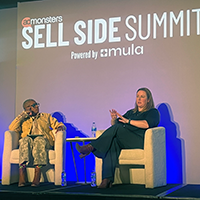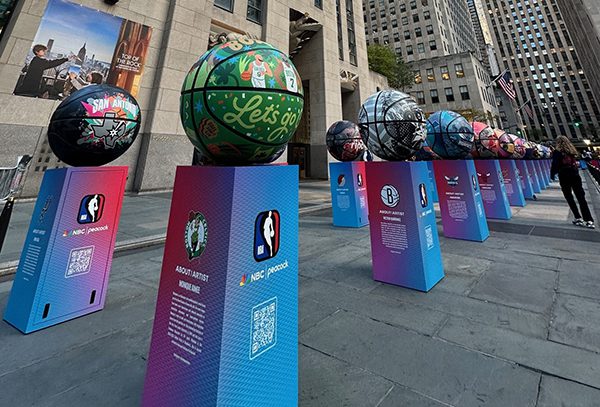Direct mail is getting more personal. And you can thank your printer.
In keeping with the general growth of one-to-one marketing and the demand for more finely targeted materials, DM printers have expanded their capabilities in new and interesting ways.
For example, Webcraft Direct Marketing (formerly Webcraft Technologies) of North Brunswick, NJ, recently teamed with database marketing services firm Naviant Inc. Webcraft can print the names and addresses of mail recipients as well as pictures based on database information about the recipients’ affinities, like sports or other interests, says marketing manager Stan Humpton.
Webcraft can do this thanks to digital asset management and variable data printing, the growing practices by which printers can store all their images and text on magnetic tapes and create templates that can be easily (and inexpensively) interchanged. These methods are being used more widely than ever before, he notes.
Desktop Customization
And it’s getting to the point where marketers can customize mail pieces from their desktops and use them to target small, specialized groups. One system, Print-to-Win, comes from Morristown, NJ-based Click Update. It lets salespeople design and print customized brochures and other sales literature for specific customers through digital images stored at their company headquarters, says Click Update marketing director Rich Thoma. Click Update has also just started working toward expanding Print-to-Win services to direct mail.
“Salespeople calling on healthcare companies can choose pictures of hospitals and doctors and copy that speak directly to this market,” Thoma notes. “[Print-to-Win] also has wild-card features that allow individual salespeople to put in any copy or image they want.”
Among the first users of this system is Reynolds & Reynolds, a Dayton, OH company that publishes documents and sales materials for the automotive industry and others. For the most part, the firm has sold its services to the purchasing departments of its customers – mostly Fortune 1000 companies – says senior digital print marketing manager Monique O’Brien. Now, Reynolds & Reynolds is taking aim at its clients’ marketing departments.
Specifically, Print-to-Win allows the company’s more than 700 field salespeople to create and print their sales and marketing materials online, download them to their desktops and/or e-mail them to prospects.
Reynolds & Reynolds, which also acts as a reseller for Click Update, has made 100 sales presentations of this system and nailed down two clients. O’Brien anticipates that Print-to-Win will help the firm’s revenue grow by 10% this year.
Cost Cutter
Another benefit of one-to-one printing systems is that they enable direct marketers to save money by having just enough products on hand to fulfill actual orders rather than stocking huge inventories, says Will Mansfield, spokesman for Agfa, the Belgian printing system manufacturer. Agfa recently formed a marketing partnership with competing manufacturer Xeikon N.V.; the two firms make variable-data printing presses (see “Combine and Conquer,” below).
Last year, Novartis Seed Co., Minneapolis, scored a 32% sales increase over the past year – all from its dealers – by sending four-color seed brochures tailored to each of them. The pieces were printed on an Agfa variable-data Chromapress.
Overall, these small digital printing runs don’t come cheap. Webcraft’s Humpton defends them by explaining that digital catalogs aimed at 1,000 customers and costing $1 per page may help their clients sell more products than a 1-million-piece offset catalog mailing priced at 10 cents per page.
The high demand for more precise personalization has raised other costs, too, says Ronald Covelli, president of Quebecor World Direct in Chicago. “There’s more software available for personalization now, but we’ve had to hire more programmers.”
Webcraft’s Humpton predicts the prices of digital printing equipment will drop once the technology becomes more widely used. “It’s like high-definition TVs, which now cost $7,000,” he says. “They’ll probably fall to $500 in the next few years.”
Meanwhile, Banta Integrated Media, the Menasha, WI printer’s digital unit, recently broke out a pay-as-you-go method for B}Media, its digital content management service.
“Not every cataloger can necessarily afford the initial cost of setting up systems and getting enough qualified people to run them,” says company director Frank Leibly. He notes that start-up costs ranging from $100,000 to several million dollars may be too steep for catalogs that turn over, say, $20 million a year.
“We’re trying to bring variable- data printing and one-to-one marketing to the masses,” quips Leibly.
But targeting has to be precise. “I’d rather err in a mass mailing than on a piece going to one or two people,” says Elizabeth Scharon, marketing director at RRD Direct, Chicago. “And I’d do a lot of testing.”
RRD Direct is offering retail clients a service enabling them to print local maps on the back of mailing pieces based on recipients’ ZIP codes. And this month, it’s introducing a service it developed with Experian that will let clients finely track responses to their mailings.
Net Effect
Of course, the Internet is having an impact on the printing world.
For example, Banta has begun to offer technologies that allow Web marketers like bookseller Amazon.com to use data from individual customer behavior on its site to design customized mailing pieces.
Quebecor’s Covelli says his company has the capability to move pages from Internet catalogs to paper catalogs, but the firm isn’t seeing much demand from customers right now. “Companies might be seeking different audiences with each medium,” Covelli says.
Some technical problems with this process still need to be addressed. According to Martin Everett, production director at international catalog design firm AGA Catalog Marketing & Design, current cathode-ray-tube computer screens have a resolution of 72 dots per inch while paper catalogs are printed in the much sharper resolution of 150 dpi. He forecasts a wait of three to five years for high-definition televisions to become commonplace and for such Web-to-paper transfers to be more easily accomplished.
But this doesn’t mean the two media are completely incompatible. One thing that’s happening to some degree is that catalogers are transposing images from catalogs to the Web. “We can repurpose elements,” says Everett.
Advances in printing and database technology are coming on fast and furious, according to Alex Hamilton, a Philadelphia consultant. And even more impressive developments probably will appear this month at DRUPA 2000, a massive two-week print industry trade show held once every five years in Dusseldorf, Germany.
It was at DRUPA ’95 where new techniques that have become widely used, like computer-to-plate prepress, were introduced.
Breakneck developments in digital printing and on the Internet are leading some of the world’s largest printing firms to combine operations and create new companies.
For one thing, Belgian printing system maker Xeikon N.V. is looking to spread around the variable-data digital color printing technology developed by Agfa. So the two firms have agreed to an alliance that calls for Agfa to sell its digital front-end technology, manufacturing operations and other assets to Xeikon. This was the same technology that enabled Novartis Seed Co. to precisely customize seed brochures it sent to its dealers last year.
“By making full use of the synergies between our two companies, we can increase the impact of integrated digital printing activities,” said Agfa group CEO Klaus Seeger in a statement. “Agfa [will pursue] a long-term interest in the digital printing industry and its promising market applications.”
Taking this one step further, in April Xeikon finalized an original equipment manufacturer agreement with MAN Roland, reportedly the world’s second-largest printing system manufacturer. MAN Roland is using Xeikon’s technology to develop a product line it’s making available worldwide this month.
Similarly, Montreal printer Quebecor World has formed subsidiary Que-Net Media to offer what it describes as a full range of digital and pre-media assets. It will be working together with new media company Informission-Intellia to furnish these services.
“The development of the World Wide Web as a new medium of communication has expanded the demand for both print products and digital content service,” said Quebecor World CEO Charles G. Cavell.



